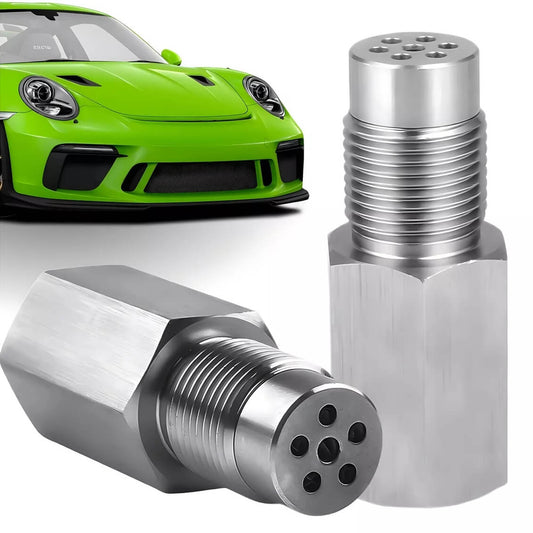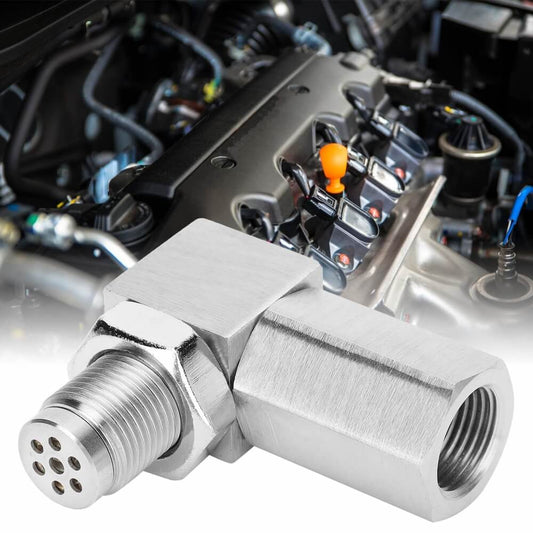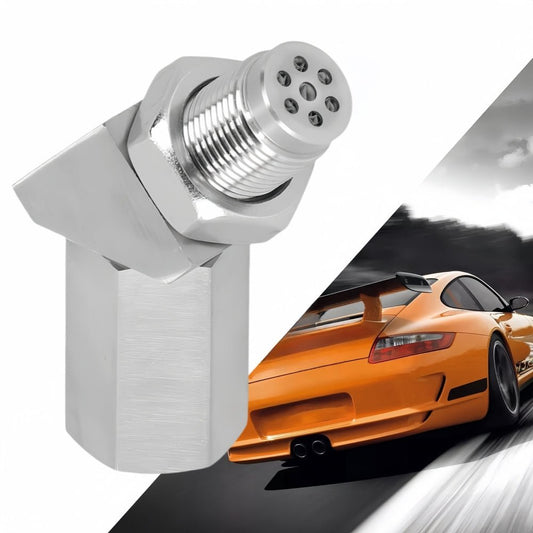How Mini Catalizador (Mini Catalytic Converter) Works
Share
Mini Catalizador is an innovative product that combines an O2 sensor spacer with a built-in mini catalytic converter, designed to address Check Engine Light (CEL) warnings caused by modified exhaust systems or the removal of catalytic converters. Its operation is based on the principles of catalytic conversion, simulating the function of a traditional catalytic converter to "trick" the vehicle’s Electronic Control Unit (ECU) into thinking that the catalytic converter in the exhaust system is still functioning properly.

Catalytic Conversion Principle
In a vehicle's exhaust system, the primary function of the catalytic converter is to convert harmful gases into harmless gases. A traditional catalytic converter contains a ceramic honeycomb structure coated with precious metals (such as platinum, palladium, and rhodium). These metal catalysts facilitate reactions between harmful substances and oxygen, converting them into carbon dioxide (CO2) and water (H2O), while reducing nitrogen oxides (NOx) into nitrogen (N2) and oxygen (O2). This not only reduces harmful emissions but also improves the vehicle's compliance with emission standards.
Role of the Post-Oxygen Sensor
Most modern vehicles (especially OBD-II vehicles manufactured after 1996) are equipped with two sets of oxygen sensors: one located before the catalytic converter and another located after it. The pre-catalytic oxygen sensor primarily monitors and adjusts the air/fuel mixture to ensure optimal engine performance. The post-catalytic oxygen sensor, however, is responsible for checking whether the catalytic converter is functioning properly. It compares the oxygen content in the exhaust before and after the catalytic converter. If the oxygen content difference is too small, the ECU will interpret this as a sign that the catalytic converter has failed, triggering the CEL.
Function of Mini Catalizador
When a vehicle undergoes an exhaust system modification, especially when replacing it with a high-flow catalytic converter (HIFLOW Cat) or deleting the catalytic converter entirely, the exhaust flow and temperature change, which may cause the post-oxygen sensor to detect abnormal signals. This can lead to the ECU mistakenly diagnosing the catalytic converter as malfunctioning, triggering the CEL warning and entering "limp mode." To prevent this, Mini Catalizador adjusts the position of the post-oxygen sensor to keep it from being directly exposed to the high-temperature exhaust flow, while the built-in mini catalytic converter processes the exhaust and simulates the function of a traditional catalytic converter.
The mini catalytic converter inside the Mini Catalizador uses a ceramic honeycomb structure coated with platinum, palladium, and rhodium, which acts as a catalyst to accelerate the conversion of harmful gases. As the exhaust gases pass through these metal catalysts, a chemical reaction occurs, converting harmful carbon monoxide (CO), nitrogen oxides (NOx), and hydrocarbons (HC) into harmless carbon dioxide (CO2) and water (H2O). This catalytic reaction effectively reduces emissions while ensuring that the oxygen sensor still receives normal exhaust data.
How It "Tricks" the ECU
Mini Catalizador "tricks" the ECU by relocating the post-oxygen sensor so that it is no longer directly exposed to the high-temperature exhaust flow. The built-in catalytic converter simulates the function of a traditional catalytic converter, causing the ECU to detect signals indicating that a functioning catalytic converter is still present in the exhaust system. This simulated effect makes the ECU believe that the catalytic converter is still operating normally, solving the P0420 and P0430 trouble codes caused by exhaust system modifications or catalytic converter removal.
Advantages of the Built-in Mini Catalytic Converter
The built-in mini catalytic converter does more than just alter the position of the oxygen sensor. It uses a ceramic honeycomb structure and precious metal catalysts to efficiently convert harmful gases and reduce emissions at high temperatures. Mini Catalizador can operate reliably in temperatures up to 620°C and is resistant to corrosion and oxidation, ensuring long-term reliability.
Suitable Applications
Mini Catalizador is highly suitable for modified high-flow exhaust systems, including those with high-flow catalytic converters, test pipes, turbocharged or non-turbocharged exhaust systems, and more. It is compatible with most vehicles that feature an M18 x 1.5mm O2 sensor interface and can be used in vehicles with engine displacements ranging from 1.6L to 6.3L, whether turbocharged or naturally aspirated.
Summary
Mini Catalizador cleverly combines an O2 sensor spacer with a mini catalytic converter to simulate the function of a traditional catalytic converter. By using precious metal catalysts, it accelerates the conversion of harmful gases. This innovative design resolves ECU trouble codes caused by high-flow exhaust systems or catalytic converter removal, while also reducing emissions and improving engine performance. Its installation is simple and requires no welding or electrical modifications, making it a highly efficient and environmentally friendly solution.

Catalytic Conversion Principle
In a vehicle's exhaust system, the primary function of the catalytic converter is to convert harmful gases into harmless gases. A traditional catalytic converter contains a ceramic honeycomb structure coated with precious metals (such as platinum, palladium, and rhodium). These metal catalysts facilitate reactions between harmful substances and oxygen, converting them into carbon dioxide (CO2) and water (H2O), while reducing nitrogen oxides (NOx) into nitrogen (N2) and oxygen (O2). This not only reduces harmful emissions but also improves the vehicle's compliance with emission standards.
Role of the Post-Oxygen Sensor
Most modern vehicles (especially OBD-II vehicles manufactured after 1996) are equipped with two sets of oxygen sensors: one located before the catalytic converter and another located after it. The pre-catalytic oxygen sensor primarily monitors and adjusts the air/fuel mixture to ensure optimal engine performance. The post-catalytic oxygen sensor, however, is responsible for checking whether the catalytic converter is functioning properly. It compares the oxygen content in the exhaust before and after the catalytic converter. If the oxygen content difference is too small, the ECU will interpret this as a sign that the catalytic converter has failed, triggering the CEL.
Function of Mini Catalizador
When a vehicle undergoes an exhaust system modification, especially when replacing it with a high-flow catalytic converter (HIFLOW Cat) or deleting the catalytic converter entirely, the exhaust flow and temperature change, which may cause the post-oxygen sensor to detect abnormal signals. This can lead to the ECU mistakenly diagnosing the catalytic converter as malfunctioning, triggering the CEL warning and entering "limp mode." To prevent this, Mini Catalizador adjusts the position of the post-oxygen sensor to keep it from being directly exposed to the high-temperature exhaust flow, while the built-in mini catalytic converter processes the exhaust and simulates the function of a traditional catalytic converter.
The mini catalytic converter inside the Mini Catalizador uses a ceramic honeycomb structure coated with platinum, palladium, and rhodium, which acts as a catalyst to accelerate the conversion of harmful gases. As the exhaust gases pass through these metal catalysts, a chemical reaction occurs, converting harmful carbon monoxide (CO), nitrogen oxides (NOx), and hydrocarbons (HC) into harmless carbon dioxide (CO2) and water (H2O). This catalytic reaction effectively reduces emissions while ensuring that the oxygen sensor still receives normal exhaust data.
How It "Tricks" the ECU
Mini Catalizador "tricks" the ECU by relocating the post-oxygen sensor so that it is no longer directly exposed to the high-temperature exhaust flow. The built-in catalytic converter simulates the function of a traditional catalytic converter, causing the ECU to detect signals indicating that a functioning catalytic converter is still present in the exhaust system. This simulated effect makes the ECU believe that the catalytic converter is still operating normally, solving the P0420 and P0430 trouble codes caused by exhaust system modifications or catalytic converter removal.
Advantages of the Built-in Mini Catalytic Converter
The built-in mini catalytic converter does more than just alter the position of the oxygen sensor. It uses a ceramic honeycomb structure and precious metal catalysts to efficiently convert harmful gases and reduce emissions at high temperatures. Mini Catalizador can operate reliably in temperatures up to 620°C and is resistant to corrosion and oxidation, ensuring long-term reliability.
Suitable Applications
Mini Catalizador is highly suitable for modified high-flow exhaust systems, including those with high-flow catalytic converters, test pipes, turbocharged or non-turbocharged exhaust systems, and more. It is compatible with most vehicles that feature an M18 x 1.5mm O2 sensor interface and can be used in vehicles with engine displacements ranging from 1.6L to 6.3L, whether turbocharged or naturally aspirated.
Summary
Mini Catalizador cleverly combines an O2 sensor spacer with a mini catalytic converter to simulate the function of a traditional catalytic converter. By using precious metal catalysts, it accelerates the conversion of harmful gases. This innovative design resolves ECU trouble codes caused by high-flow exhaust systems or catalytic converter removal, while also reducing emissions and improving engine performance. Its installation is simple and requires no welding or electrical modifications, making it a highly efficient and environmentally friendly solution.





